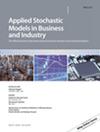A new extended δ-shock model with the consideration of shock magnitude
IF 1.3
4区 数学
Q3 MATHEMATICS, INTERDISCIPLINARY APPLICATIONS
引用次数: 0
Abstract
In this article, a new -shock model that takes into account the magnitude of shocks is introduced and studied from reliability perspective. According to the new model, the system breaks down if either a shock after non-critical shock occurs in a time length less than or a shock after a critical shock occurs in a time length less than where . The distribution of the system's lifetime is studied for both discrete and continuous intershock time distributions. It is shown that a new model is useful to describe a certain cold standby repairable system.
考虑冲击幅度的新扩展δ冲击模型
本文介绍了一种考虑冲击大小的新冲击模型,并从可靠性角度对其进行了研究。根据新模型,如果非临界冲击后的冲击发生的时间长度小于 或临界冲击后的冲击发生的时间长度小于 。对离散和连续冲击间时间分布的系统寿命分布进行了研究。结果表明,新模型有助于描述某种冷备用可修复系统。
本文章由计算机程序翻译,如有差异,请以英文原文为准。
求助全文
约1分钟内获得全文
求助全文
来源期刊
CiteScore
2.70
自引率
0.00%
发文量
67
审稿时长
>12 weeks
期刊介绍:
ASMBI - Applied Stochastic Models in Business and Industry (formerly Applied Stochastic Models and Data Analysis) was first published in 1985, publishing contributions in the interface between stochastic modelling, data analysis and their applications in business, finance, insurance, management and production. In 2007 ASMBI became the official journal of the International Society for Business and Industrial Statistics (www.isbis.org). The main objective is to publish papers, both technical and practical, presenting new results which solve real-life problems or have great potential in doing so. Mathematical rigour, innovative stochastic modelling and sound applications are the key ingredients of papers to be published, after a very selective review process.
The journal is very open to new ideas, like Data Science and Big Data stemming from problems in business and industry or uncertainty quantification in engineering, as well as more traditional ones, like reliability, quality control, design of experiments, managerial processes, supply chains and inventories, insurance, econometrics, financial modelling (provided the papers are related to real problems). The journal is interested also in papers addressing the effects of business and industrial decisions on the environment, healthcare, social life. State-of-the art computational methods are very welcome as well, when combined with sound applications and innovative models.

 求助内容:
求助内容: 应助结果提醒方式:
应助结果提醒方式:


